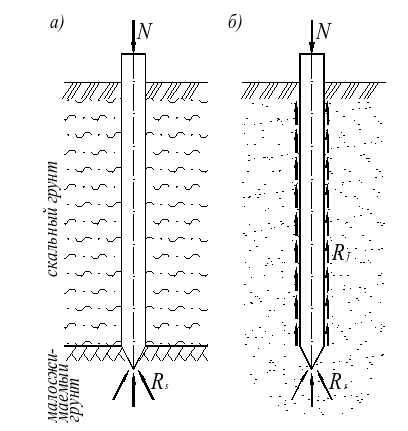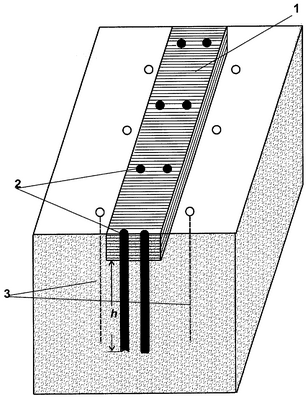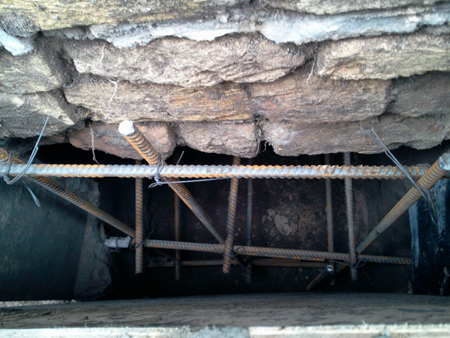Unstable soil is a common problem that many builders face when building a foundation. To obtain solid foundation, piles are used on soft soil. Their length compensates for the lack of support, and the frictional forces of the side surfaces on the ground help to stay in the soil. Depending on the nature of the layer and the method of interaction with the soil bedding, a distinction is made between friction piles and stand piles.
Difference between hanging piles and stand piles
The first category includes supports that rest on compressible soils. Their structure allows, using the lower end and side surface, to redirect the load onto the soil base.
The second category includes supports resting on low-compressible soils, which include clayey and coarse-grained rocks with dense sand filler.
Hanging piles and rack piles have a similar structure and appearance, but they differ radically in the principle of operation and basic technologies for ensuring the safety of the future structure.
Hanging structures are used when working with strong layers of soil lying at great depths. The task of such supports is to pass through the thickness of weak soil and anchor the lower end in a strong soil layer. Achieving this goal is possible only with proper calculation of the length of the suspended pile, which takes into account the following indicators:
- The density of the material from which it is composed.
- Working length.
- Characteristics of soil features: mobility, looseness, moisture saturation.
- Design load of the future building: the greater its value, the deeper the hanging pile should be installed.
The principle of the pile rack
 The principle of the pile rack
The principle of the pile rack
A pile rack is a structure up to 20 m long, which passes through unstable soil layers and is fixed in a hard surface at a depth of 0.5 meters or more. Unlike a hanging one, this support prevents the gradual settlement of the building, exerting a load on the solid soil not with its entire body, but at the expense of the lower part. Rack piles are widely used for laying pipelines and in large-scale industrial construction. Such supports can also be used in areas with unpredictable seismic activity.
To calculate the optimal length of the pile, the racks are guided by the following indicators:
- soil strength;
- the ability of a solid foundation to bear the mass of a future building;
- material for making the rack pile.
Advantages and disadvantages of support structures
Depending on the material of manufacture, wooden, concrete, reinforced concrete, metal, solid, and hollow products are distinguished. An important selection criterion is the installation method, which divides supports into driven, drilled, pressed, screw and pressed ones.
Post foundation piles are considered more reliable than friction piles, which are not supported by a load-bearing layer of soil.
This significant drawback can be eliminated in several ways:
- Increasing the cross-sectional area.
- Increasing length.
- Diameter expansion.
- By adding more supports per unit area.
However, such methods are not justified from the point of view of economy and practicality.
Thus, increasing the size of a product by changing the cross-sectional area, length and diameter leads to additional costs of money and effort: the purchase of additional large-sized lifting equipment, the cost of related building materials, the hiring of qualified workers, the general increase in the cost of the foundation, the price of which is the sum of the cost of each element.
The thoughtless use of additional supports significantly makes the structure heavier and leads to settlement of the structure. In turn, uneven subsidence of the foundation entails unpleasant consequences, which begin with the appearance of cracks on the walls and end with the destruction of the structure.
Thus, strengthening the foundation is a labor-intensive process that requires certain professional skills and special equipment. The choice of support products is based on initial requirements and technical and economic comparison.
Weak soils are a very big problem in construction. In order to secure and secure the entire structure, two basic technologies using piles were developed:
- First technology. Friction piles are supports that rest on directly compressible soil.
- Second technology. A pile stand is a fairly long structure that penetrates weak layers and penetrates the hard layers of soil at least half a meter.
Each of these technologies has its own pros and cons, so when considering the topic, we suggest, without delving into the intricacies, to go through the basic points.
Two technologies - two entities

Let's try to understand the problem of installation on soft soils. Rack piles and hanging foundations, although similar in appearance, will differ in their operating principle.
So:
- The pile-rack resembles a compressed rod that transfers the entire load from the carried mass to low-compressible soil layers. In this case, it is actually the lower part of the structure that actually redistributes the loads on the ground, and not its entire body. When making calculations, it is necessary to pay attention to the strength of the soil, and specifically its ability to bear the weight of the structure, as well as the strength of the material from which the pile is made.
- Hanging piles act completely differently. In this case, the pile is supported on directly compressible soils, and not on strong deep layers. Piles carry the load due to friction of the entire body of the product, and not just the tip. And this is a significant disadvantage of this design.
Ways to solve the problem

To solve the problem of increasing reliability hanging piles Several technological developments were developed and implemented, here are some of them:
- Increasing the diameter of the piles, and in some cases the length;
- Increasing the “bushiness” of supports per unit area of the building foundation;
- Extension of the heel of the product. In this case, the friction area at the end of the product increases;
- Applications modern technologies discharge-pulse type.
However, practical application has shown a not very bright prospect for such techniques:
- Firstly, any increase in the size of the product leads to an increase in the cost of the entire construction, since the price of the entire foundation consists of the prices for each element. In addition, it is worth remembering that the thicker the pile, the more difficult it is to drive it into the ground;
- Secondly, the number of “driven” supports for such reinforcement can make the structure heavier, both literally and financially, but may not bring the desired benefit:
- A bushy structure is subject to settlement of more than one pile;
- The length of the standard support is 7 meters, while the draft single pile and the bush are approximately the same, but there is a paradox.

Interesting to know! There is an interesting practical observation. If the distance between the piles is more than three diameters, then the settlement of a single support and a bush is approximately the same; as this distance decreases, the shrinkage of the foundation increases sharply.
New technologies

New technologies are faced with a seemingly impossible task, namely, increasing the load-bearing capacity of existing pins. And this is on labile, weak soils. The purpose of this technique is to increase the frictional forces on the surface of the piles and the soil located around them.
The instructions for using the technology assume the following procedure:
- In the existing foundation, they drill in increments of 1.5 to 2 meters and compact the soil under high pressure until hydraulic fracturing cavities are formed. Drilling is carried out in the space between the piles and at the base of the installed piles;
For your information! Under influence high pressure the soil is compacted near the existing foundations; to achieve maximum results, drilling is carried out to a depth of one to two and a half meters deeper than the level of the main piles. In addition to the usual direction of filling with a quick-hardening solution, multidirectional injectors are used, which allow you to rake the soil specifically under already installed structures.

- In existing buildings, if available slab foundation injectors are inserted throughout the tile field, covering squares from one and a half by one and a half meters to two by three meters. All operations take place in the basement;
- The injection of the solution occurs in stages; the ideal is to fill the shafts running and adjacent to each other. Thus, there is a targeted displacement of the soil towards a specific support and the support of this newly formed cushion with peculiar reinforcing belts made of cement mixture.
Positive characteristics of this method:
- Compaction of soil with reinforcement elements occurs without complex earthworks, the use of heavy equipment and additional construction crews;
- Blowing the cement mixture under pressure allows you to increase the friction force between compacted soils and the surface of native piles, which in turn will increase the efficiency of the bearing capacity of the structure by 2 times;
- The proposed technology will make it possible to repair the foundation of an existing building and enhance the capabilities of hanging supports. Since the classical technology involves the construction of new piles and redistribution of the load on them, which is practically impossible, this inconvenience is leveled out in the new method.
When constructing foundations on soft soils, piles are used different types. They differ in the material of manufacture, immersion method, size and cross-sectional shape. According to the method of interaction with soil layers, such structures belong to one of two groups - hanging piles or racks.
In the first case, the pillars rest not on a solid base, but on compressible soils, transmitting loads through the side surfaces and the tip. The second group of piles is supported by low- or incompressible soils, which take on the forces from the tip or expanded heel of the foundation shafts. With this interaction, the soil resistance forces on the side walls of the foundation supports are not taken into account in the calculation of their bearing capacity.
Types and features of piles
According to the method of installation in the design position, both hanging and pile racks are divided into:- driving;
- pressable;
- printed;
- drilling;
- screw.
They can be concrete and reinforced concrete, metal and wood, hollow and solid. A hanging pile does not rest on a load-bearing soil layer like foundation piers, and this is its main disadvantage. In order to increase the reliability of a “supportless” foundation, several methods are used:
- increasing the cross-sectional area or length of the pile column;
- adding the number of piles per unit area;
- camouflage heel widening device.
But these methods are not always justified. For example, an increase in size always leads to additional material investments, increased labor intensity of work, as well as the need to order more powerful and expensive equipment. The use of additional piles in bushes can lead to the opposite effect, since the weighting of the structure will lead to a greater settlement of the structure. By the way, reducing the step between point supports leads to the same result. But in some situations, the option of increasing bushiness saves the situation and turns out to be more suitable than installing rack piles.

The widened heel is advantageous in that it makes it possible to additionally support the hanging trunk on the ground. However for driven pile, in this case, there are some inconveniences. The technology does not allow her to dive.
Uneven settlement of the foundation leads to the appearance of cracks on the walls of the building and its possible destruction.
The length of the hanging piles is determined depending on the design load of the structure and the “weakness” of the soils lying on the site. The larger the first component and the smaller the second, the deeper the pile supports are installed. In some cases they are made composite.
The rack piles rest on a solid layer of soil, transferring loads from the ground part of the structure to it. They are often recessed some distance deep, which increases the reliability of the foundation and prevents any precipitation. The length of the trunks can be 20m or more.
Calculation of a suspended driven pile
The load-bearing capacity (F d, kN) of hanging shells, as well as piles, is determined by the formula specified in the corresponding section of SNiP 2.02.03-85. The calculation is based on several real indicators. These include:
- u- cross-sectional perimeter of the driven support in meters;
- A- area of the pile pillar, shell or largest section of the camouflage widening in square meters;
- H i - the thickness of each of the soil layers located in the immediate vicinity of the side surfaces of the driven pile support, in meters.
The calculation also includes table values:
- R- calculated value of the resistance of the soil layer located under the lower part of the pile, in kPa (Table 1);
- Fi– calculated values of the resistance of each of the soil layers in contact with the side surface of the foundation support, in kPa (Table 2);
- Y c= 1 – coefficient that determines the operating conditions of the structure;
- Y cr– the same, under the tip of the pile (Table 3);
- Ycf– the same, on the side surface, taking into account the method of deepening the support (Table 3).

The calculation for the compressive load itself is carried out according to the formula:
F d = Yс * (Ycr * R * A + u * Σ Ycf * Fi * Hi).
, having inclined side edges, are calculated using a slightly different formula, which takes into account the magnitude of the slope and different meanings cross-sectional areas of the foundation column.
Another calculation of the load-bearing capacity of a driven pile and shell, which does not involve excavation, is performed for a pull-out load. The notations here are the same as in the previous formula, however, the operating conditions coefficient ( Yc) has other indicators. When the support is deepened to 4 meters, it is equal to 0.6, and more than 4 meters - 0.8. It should be noted that these values do not apply to the foundation for power line supports. The formula for calculation is as follows:
F du = Yс * u * Σ Ycf * Fi * Hi
Driven and drilled types of hanging piles are calculated using the same formulas, but taking into account the conditions of the well construction and shaft concreting, which affect the coefficient γ cf. It is determined according to Table 5 of the same SNiP. The standard also describes some other features of the calculation.
Rack piles
Their load-bearing capacity is determined by a simplified formula:
F d = Yс * R * A.
The letter designations here correspond to those previously described. The only difference is that the value of R, which determines the soil resistance under the lower part of the rack pile, is not taken from tables, but is calculated using formulas.
